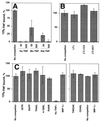CrmE, a novel soluble tumor necrosis factor receptor encoded by poxviruses
- PMID: 11119592
- PMCID: PMC113916
- DOI: 10.1128/JVI.75.1.226-233.2001
CrmE, a novel soluble tumor necrosis factor receptor encoded by poxviruses
Abstract
Cytokines and chemokines play a critical role in both the innate and acquired immune responses and constitute prime targets for pathogen sabotage. Molecular mimicry of cytokines and cytokine receptors is a mechanism encoded by large DNA viruses to modulate the host immune response. Three tumor necrosis factor receptors (TNFRs) have been identified in the poxvirus cowpox virus. Here we report the identification and characterization of a fourth distinct soluble TNFR, named cytokine response modifier E (CrmE), encoded by cowpox virus. The crmE gene has been sequenced in strains of the orthopoxviruses cowpox virus, ectromelia virus, and camelpox virus, and was found to be active in cowpox virus. crmE is expressed as a secreted 18-kDa protein with TNF binding activity. CrmE was produced in the baculovirus and vaccinia virus expression systems and was shown to bind human, mouse, and rat TNF, but not human lymphotoxin alpha, conjugates of lymphotoxins alpha and beta, or seven other ligands of the TNF superfamily. However, CrmE protects cells only from the cytolytic activity of human TNF. CrmE is a new member of the TNFR superfamily which is expressed as a soluble molecule that blocks the binding of TNF to high-affinity TNFRs on the cell surface. The remarkable finding of a fourth poxvirus-encoded TNFR suggests that modulation of TNF activity is complex and represents a novel viral immune evasion mechanism.
Figures






Similar articles
-
Comparative Biochemical and Functional Analysis of Viral and Human Secreted Tumor Necrosis Factor (TNF) Decoy Receptors.J Biol Chem. 2015 Jun 26;290(26):15973-84. doi: 10.1074/jbc.M115.650119. Epub 2015 May 4. J Biol Chem. 2015. PMID: 25940088 Free PMC article.
-
Structure of CrmE, a virus-encoded tumour necrosis factor receptor.J Mol Biol. 2007 Sep 21;372(3):660-71. doi: 10.1016/j.jmb.2007.06.082. Epub 2007 Jul 3. J Mol Biol. 2007. PMID: 17681535
-
Vaccinia virus CrmE encodes a soluble and cell surface tumor necrosis factor receptor that contributes to virus virulence.Virology. 2002 Jan 20;292(2):285-98. doi: 10.1006/viro.2001.1236. Virology. 2002. PMID: 11878931
-
Tumor necrosis factor receptors encoded by poxviruses.Mol Genet Metab. 1999 Aug;67(4):278-82. doi: 10.1006/mgme.1999.2878. Mol Genet Metab. 1999. PMID: 10444338 Review.
-
TNF Decoy Receptors Encoded by Poxviruses.Pathogens. 2021 Aug 22;10(8):1065. doi: 10.3390/pathogens10081065. Pathogens. 2021. PMID: 34451529 Free PMC article. Review.
Cited by
-
Poxvirus-encoded TNF receptor homolog dampens inflammation and protects from uncontrolled lung pathology during respiratory infection.Proc Natl Acad Sci U S A. 2020 Oct 27;117(43):26885-26894. doi: 10.1073/pnas.2004688117. Epub 2020 Oct 12. Proc Natl Acad Sci U S A. 2020. PMID: 33046647 Free PMC article.
-
Ectromelia-encoded virulence factor C15 specifically inhibits antigen presentation to CD4+ T cells post peptide loading.PLoS Pathog. 2020 Aug 3;16(8):e1008685. doi: 10.1371/journal.ppat.1008685. eCollection 2020 Aug. PLoS Pathog. 2020. PMID: 32745153 Free PMC article.
-
Challenges and Achievements in Prevention and Treatment of Smallpox.Vaccines (Basel). 2018 Jan 29;6(1):8. doi: 10.3390/vaccines6010008. Vaccines (Basel). 2018. PMID: 29382130 Free PMC article. Review.
-
Poxviridae Pneumonia.Adv Exp Med Biol. 2024;1451:183-204. doi: 10.1007/978-3-031-57165-7_12. Adv Exp Med Biol. 2024. PMID: 38801579 Review.
-
Inhibition of interferons by ectromelia virus.J Virol. 2002 Feb;76(3):1124-34. doi: 10.1128/jvi.76.3.1124-1134.2002. J Virol. 2002. PMID: 11773388 Free PMC article.
References
-
- Aguado B, Selmes I P, Smith G L. Nucleotide sequence of 21.8 kbp of variola major virus strain Harvey and comparison with vaccinia virus. J Gen Virol. 1992;73:2887–2902. - PubMed
-
- Alcami A, Khanna A, Paul N L, Smith G L. Vaccinia virus strains Lister, USSR and Evans express soluble and cell-surface tumour necrosis factor receptors. J Gen Virol. 1999;80:949–959. - PubMed
-
- Alcami A, Smith G L. Receptors for γ-interferon encoded by poxviruses: implications for the unknown origin of vaccinia virus. Trends Microbiol. 1996;4:321–326. - PubMed
-
- Alcami A, Smith G L. A soluble receptor for interleukin-1β encoded by vaccinia virus: a novel mechanism of virus modulation of the host response to infection. Cell. 1992;71:153–167. - PubMed
Publication types
MeSH terms
Substances
Grants and funding
LinkOut - more resources
Full Text Sources
Other Literature Sources

